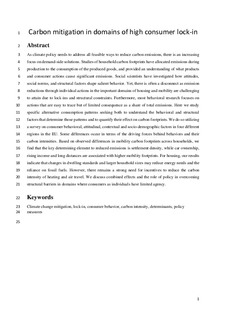Carbon mitigation in domains of high consumer lock-in
Ivanova, Diana; Vita, Gibran; Wood, Richard; Lausselet, Carine; Dumitru, Adina; Krause, Karen; Macsinga, Irina; Hertwich, Edgar G.
Journal article
Submitted version
Permanent lenke
http://hdl.handle.net/11250/2587498Utgivelsesdato
2018Metadata
Vis full innførselSamlinger
Sammendrag
As climate policy needs to address all feasible ways to reduce carbon emissions, there is an increasing focus on demand-side solutions. Studies of household carbon footprints have allocated emissions during production to the consumption of the produced goods, and provided an understanding of what products and consumer actions cause significant emissions. Social scientists have investigated how attitudes, social norms, and structural factors shape salient behavior. Yet, there is often a disconnect as emission reductions through individual actions in the important domains of housing and mobility are challenging to attain due to lock-ins and structural constraints. Furthermore, most behavioral research focuses on actions that are easy to trace but of limited consequence as a share of total emissions. Here we study specific alternative consumption patterns seeking both to understand the behavioral and structural factors that determine those patterns and to quantify their effect on carbon footprints. We do so utilizing a survey on consumer behavioral, attitudinal, contextual and socio-demographic factors in four different regions in the EU. Some differences occur in terms of the driving forces behind behaviors and their carbon intensities. Based on observed differences in mobility carbon footprints across households, we find that the key determining element to reduced emissions is settlement density, while car ownership, rising income and long distances are associated with higher mobility footprints. For housing, our results indicate that changes in dwelling standards and larger household sizes may reduce energy needs and the reliance on fossil fuels. However, there remains a strong need for incentives to reduce the carbon intensity of heating and air travel. We discuss combined effects and the role of policy in overcoming structural barriers in domains where consumers as individuals have limited agency.
